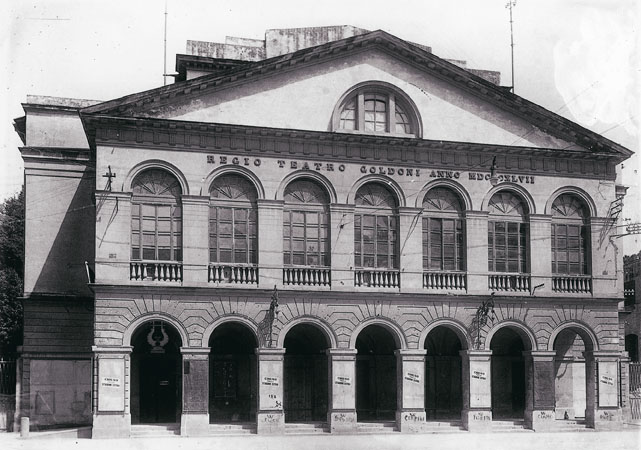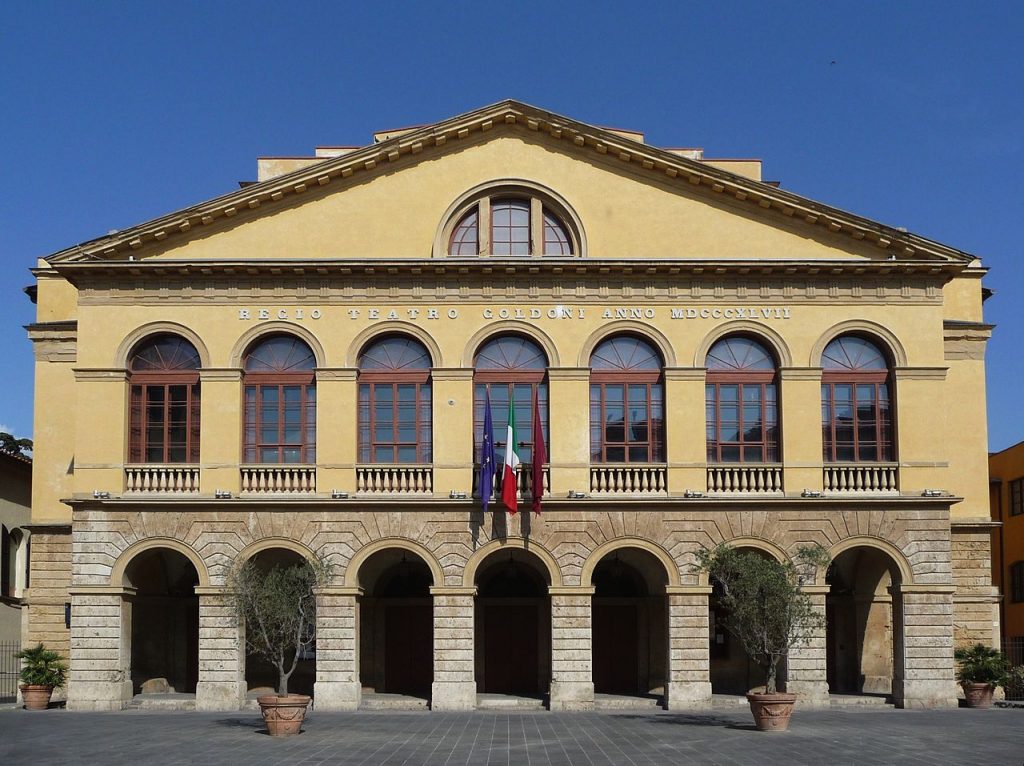Nel 1842 l’impresario Francesco Caporali, coadiuvato dal figlio Alessandro, pubblica un programma per la realizzazione di un nuovo e sontuoso teatro cittadino, destinato a rappresentazioni diurne e notturne. La progettazione viene affidata al giovane Giuseppe Cappellini, architetto livornese di cultura neoclassica, formatosi dapprima all’Accademia delle Belle Arti di Firenze e poi alla Scuola Michoniana di Livorno.
All’inizio del 1843 il Cappellini avanza un primo progetto, ancora non definitivo mentre, pochi mesi dopo, nell’agosto del medesimo anno, l’architetto presenta alla Deputazione sui lavori di pubblica utilità e ornato un progetto corredato da otto tavole che mostrano un maggiore grado di dettaglio. Già nel settembre 1843 sono avviati i lavori delle strutture murarie portanti, che si protrarranno per tutto l’anno seguente.
Frattanto l’architetto, conscio delle difficoltà realizzative del lucernario da aprirsi in mezzo alla copertura sala, modifica i suoi progetti, disegnando una copertura completamente trasparente in cristallo e sostenuta da una trama di travi in ferro. La copertura trasparente sarà posta in opera solo dopo il 1846 a causa dei numerosi ritardi subiti.
Il 24 luglio 1847 il Teatro Leopoldo, così chiamato fino all’Unità d’Italia quando sarà intitolato a Carlo Goldoni, viene inaugurato. Tuttavia, a causa dei mancati finanziamenti da parte della committenza, il sontuoso apparato decorativo previsto dal Cappellini viene solamente accennato.
In 1842 the impresario Francesco Caporali, assisted by his son Alessandro, published a program for the construction of a new and sumptuous city theater, intended for day and night performances. The design was entrusted to the young Giuseppe Cappellini, an architect from Livorno with a neoclassical culture, who first trained at the Academy of Fine Arts in Florence and then at the Michonian School of Livorno. At the beginning of 1843 Cappellini put forward a first project, still not definitive while, a few months later, in August of the same year, the architect presented to the Deputation on public utility works and decorated a project accompanied by eight tables showing a greater degree of detail. Already in September 1843 the work on the load-bearing masonry structures began, which will continue for the whole of the following year. In the meantime, the architect, aware of the difficulties in making the skylight to be opened in the middle of the room roof, modifies his projects, designing a completely transparent glass cover supported by a weave of iron beams. The transparent covering was only put in place after 1846 due to the numerous delays suffered. On 24 July 1847 the Leopoldo Theater, so called until the unification of Italy when it was named after Carlo Goldoni, was inaugurated. However, due to the lack of funding on the part of the client, the sumptuous decorative apparatus envisaged by Cappellini is only hinted at.
Pochi anni dopo l’inaugurazione il teatro subisce un rapido decadimento e viene restaurato negli anni che precedono l’Unità d’Italia; dopo alcuni passaggi di proprietà, nel 1869 viene acquistato dall’Accademia Goldoni. Complice la crisi di alcuni teatri cittadini, come il San Marco, questi sono gli anni che coincidono con una serie di spettacoli con le migliori compagnie del mondo; in particolare, nel 1890, con la rappresentazione di Cavalleria rusticana, l’attività del teatro raggiunge i massimi livelli. Infatti l’opera, del concittadino Pietro Mascagni, richiama a Livorno numerose personalità dell’epoca; da allora il teatro diviene un punto di riferimento per le opere di Mascagni. Al Goldoni si tengono comunque rappresentazioni di ogni genere, compresi gli spettacoli di varietà ed i primi esperimenti in campo cinematografico.
A few years after the inauguration the theater undergoes a rapid decay and was restored in the years preceding the unification of Italy; after a few changes of ownership, in 1869 it was bought by the Goldoni Academy. Thanks to the crisis of some city theaters, such as San Marco, these are the years that coincide with a series of shows with the best companies in the world; in particular, in 1890, with the performance of Cavalleria rusticana, the activity of the theater reached the highest levels. In fact the work, by the fellow citizen Pietro Mascagni, recalls numerous personalities of the time to Livorno; since then the theater has become a point of reference for Mascagni’s works. In any case, performances of all kinds are held at Goldoni, including variety shows and the first experiments in the field of cinema.
In 1921, the split of the Socialist Party was recorded inside the theater, which, following the assembly held at the San Marco Theater, led to the founding of the Communist Party of Italy.
Con la seconda guerra mondiale l’edificio viene requisito dalle truppe alleate che qui tengono le loro rappresentazioni.
Nel dopoguerra l’attività del teatro torna alla normalità fino agli anni ottanta. Allora, dichiarato inagibile, viene acquisito nel patrimonio comunale e sottoposto ad un impegnativo restauro. Le operazioni di recupero si concludono all’inizio del 2004; il 24 gennaio si tiene l’inaugurazione alla presenza del Presidente della Repubblica Carlo Azeglio Ciampi, con la rappresentazione della Cavalleria rusticana, celebre opera di Pietro Mascagni.
With the Second World War the building was requisitioned by the allied troops who held their representations here.
After the war, the activity of the theater returned to normal until the 1980s. Then, declared unfit for use, it is acquired in the municipal heritage and subjected to a demanding restoration. The recovery operations were completed at the beginning of 2004; on 24 January the inauguration is held in the presence of the President of the Republic Carlo Azeglio Ciampi, with the representation of the Cavalleria rusticana, a famous work by Pietro Mascagni.


